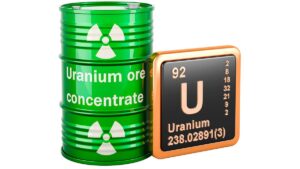Rare earths demand to get another kick up on multi-trillion-dollar cash injections from US, Europe

Rare earths is getting another kick up thanks to multi-trillion-dollar cash injections from the US and Europe. Pic: Getty Images
Recent moves in the US and Europe to make multi-trillion-dollar investments in ‘green’ infrastructure is expected to drive demand for rare earths even further north.
Leading the way is the European Commissions’ plan to spend €750bn ($1.23 trillion) on things like rolling out renewable energy projects and installing 1 million charging points for electric vehicles (EV).
The latter is a move that will undoubtedly help drive the adoption of EVs in Europe, which is already one of the global leaders in EV penetration.
Meanwhile, the US Department of Defense has announced a $US77.3m ($107.5m) ‘Defense Production Act Title III COVID-19 Actions’ program that seeks to sustain and strengthen essential domestic industrial base capabilities and defence-critical workforce in the aviation, rare earth materials, and electronics industries.
Democratic Presidential candidate Joe Biden has also committed to a $US2 trillion green infrastructure and jobs plan that includes the electrification of the US transport sector if he beats incumbent President Donald Trump in the upcoming election in November.
Proposed North American rare earths listing is a value indicator
Developments in the private sector have also brought rare earths to the forefront, with MP Materials — the owner and operator of Mountain Pass, the only large-scale rare earths mining and processing site in North America — pushing ahead with a $US1.5bn listing on the NYSE through a merger with Fortress Value Acquisition Corporation.
That MP is confident about such a large listing amid the challenges of the COVID-19 pandemic highlights the growing interest in ensuring supply chain security, particularly for rare earths such as neodymium-praseodymium (NdPr) that are critical for the manufacture of permanent magnets.
Arafura Resources (ASX:ARU) general manager exploration and development Richard Brescianini told Stockhead that MP’s move indicates there was probably a lot more liquidity in the market than expected.
“We think there is plenty of pent-up demand in this sector and maybe that’s what MP Materials is going to be accessing,” he explained.
Brescianini acknowledged that while Arafura still needed to make progress on securing offtake and progressing development of its Nolans NdPr project in the Northern Territory, the MP move was a hint at the kind of value that the company could eventually realise.
“If this thing (MP) is worth $US1.5bn and Lynas Corporation (ASX:LYC) is worth $1.7bn, what should Arafura be worth once we get up and running?”
Rare earths supply security top of the agenda
Further highlighting the interest in rare earths supply security, Lynas recently signed a contract with the US Department of Defense for phase-one work on a US heavy rare earth separation facility.
The company said the facility was part of its 2025 growth plan that would not only provide an expanded product suite but also act as the only source of separated heavy rare earths outside of China.
Brescianini says the interest in supply chain security also extends to raw materials with companies, particularly those considered to be premium manufacturers, becoming more interested in ensuring that their raw materials are sourced from jurisdictions that have the highest regard for health, safety and environmental protection.
“We are seeing some of that in our engagement in Europe at the moment,” he explained. “We are actually presenting to some of these organisations about exactly those matters because they are beginning to ask for it.”
Adding to this, Hexagon Energy Materials (ASX:HXG) strategic advisor Gavin Beer noted that the permanent magnets used in EVs and offshore wind turbines generally made up quite a small proportion of the overall product cost relative to the technology and batteries.
“It is still quite a minor cost, so I believe that the end users will always have a requirement for supply even if it is at a slight premium because it won’t affect the final unit price significantly,” he told Stockhead.
Beer added that with relations between the US and China souring, it would seem logical to factor in a risk of supply if you are solely reliant on China for these materials.
ASX small cap rare earths companies are positioning to benefit from demand growth
With the growing interest in ensuring supply chain security and expectations that EV adoption will accelerate, Australian small cap rare earths companies are also progressing their projects in the hope of catching the demand wave.
Arafura has secured a renewal of its Nolans project’s Major Project Status, which is a recognition that it is a substantial critical minerals and advanced materials development opportunity.
This comes barely a week after it received the key development leases that secures the Nolans resource for an initial 25 years with multiple renewal periods possible.
Nolans has a 33-year mine life on a reserve of 29.5 million tonnes grading 2.9 per cent total rare earth oxides (TREO). High demand and valuable NdPr makes up 26.4 per cent of the rare earths content
Australian Strategic Materials (ASX:ASM), which was spun-off from Alkane Resources (ASX:ALK), is the newest rare earths company on the ASX.
Its Dubbo project is a large in-ground polymetallic resource of zirconium, hafnium, niobium, tantalum, yttrium and rare earth elements that is ready for construction, subject to financing.
All major state and federal approvals and licences are in place, along with an established process flow sheet and a solid business case.
The project has a current resource of 75.18 million tonnes grading 1.89 per cent zircon, 0.44 per cent niobium and 0.74 per cent TREO, which includes the neodymium, dysprosium and praseodymium.
Export Finance Australia has confirmed its interest in forming part of the financing consortium for the proposed development of the Dubbo project.
ASM’s South Korean joint venture partner ZironTech has completed the first production run of 7.6kg of neodymium metal at their commercial pilot plant.
Cost-saving rare earths tech
Meanwhile, Hexagon has an option to buy into the RapidSX rare earths separation tech developed by Innovation Metals Corporation (IMC).
The tech is a “turbocharged” form of solvent extraction that promises to extract rare earths at a lower cost compared to more traditional solvent extraction methods.
Beer told Stockhead that while rare plants such as Lynas’ plant in Malaysia or Mountain Pass typically required about a hundred stages of solvent extraction to make about four mixed rare earths products, the faster ‘kinetics’ of RapidSX meant that it could achieve the same result with 20 to 30 per cent fewer stages.
“That has significant implications in regards to the capital required and of course the startup time required for a potential or existing rare earth company to go into the separation and value-add chain of the rare earths,” he added.
“It has been under development by IMC for over 10 years and they have pilot demonstrated it on quite a large scale at their facility in Canada.”
Meanwhile, Ionic Rare Earths’ (ASX:IXR) initial test work on Makuutu Eastern Zone samples have returned results consistent with those from the central zone and other similar projects confirming potential for a very large resource.
Encouragingly, recovery of high-value critical rare earth elements (CREE) and heavy rare earth elements (HREE) from the project in Uganda continues to be favoured over lower value light rare earth elements (LREE).
Drilling is underway to expand the current resource of 78.6 million tonnes grading 840 parts per million TREO.
Raising capital and restarting after COVID
Northern Minerals (ASX:NTU) is completing a $22m share placement which will be used for continued development of its Browns Range pilot project.
The company is partially restarting operations at the pilot plant along with recommencing exploration activities after biosecurity restrictions applied to the Kimberley region as part of COVID-19 control measures were lifted.
Earlier this week, Pensana Rare Earths (ASX:PM8) reported final results from its 8,000m drill program at the Longonjo NdPR project in Angola that included further high-grade intersections in fresh rock below the planned open pit.
Notable results are 18m at 7.93 per cent rare earth oxides (REO) including 1.5 per cent NdPr from surface within the weathered zone and 18m at 4.4 per cent REO including 0.86 per cent Ndpr from 44m in fresh rock.
These results confirm the continuity of the weathered zone mineralisation from surface and also outlines a wide area of mineralisation in fresh rock that could add resources beyond the initial mine life.
Work has started on an updated resource estimate to be reported in September.
RareX (ASX:REE) raised $2.3m through a share placement in June and flagged that it would kick off a 6,000m reverse circulation drilling program at its Cummins Range rare earths project this month.
In late May, a review found that NdPr makes up an average of 22.1 per cent of the Cummins Range rare earths content.
This result is in line with other carbonatite rare earth deposits including Mt Weld (24.7 per cent NdPr), Nguall (21.3 per cent NdPr) and Mountain Pass (16.3 per cent).
At Stockhead, we tell it like it is. While Arafura Resources, Hexagon Energy Materials, Ionic Rare Earths and RareX are Stockhead advertisers, they did not sponsor this article.
Related Topics

UNLOCK INSIGHTS
Discover the untold stories of emerging ASX stocks.
Daily news and expert analysis, it's free to subscribe.
By proceeding, you confirm you understand that we handle personal information in accordance with our Privacy Policy.








